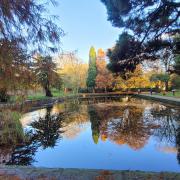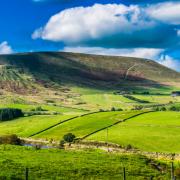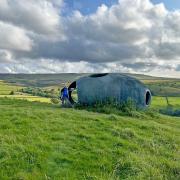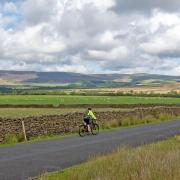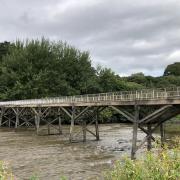Keith Carter explores the captivating and mysterious Sunderland Point
Compass points
Area of walk: Sunderland Point
Distance: 5 � miles
Time to allow: 3-3 � hours
Map: OS Explorer 294 Lancaster, Morecambe and Fleetwood
Refreshments: Pubs at Overton, snacks and toilets at Middleton Sands.
Warning: Tables should be checked in advance. The causeway and carpark are often under feet of water either side of high tide.
Sunderland village takes its name from a ‘land that is sundered from the main’ and in crossing the causeway at low tide it is possible to gain a real sense of how cut off this little outpost is. I am reminded strongly of Holy Island in Northumberland which is equally cut off by the tide. If you leave your return journey too late you risk being stranded for hours until the water recedes.
In the early 18th century Sunderland was the port for Lancaster thanks to the entrepreneurial spirit of one Robert Lawson who built a dock and ships here until Glasson (built 1787) superseded it. We are told Sunderland enjoyed a brief period of popularity as resort for sea bathing in an era when it was considered beneficial to health to immerse the body in salt water. I wouldn’t try it today, with or without a bathing machine.
The few houses that remain are arranged as terraces lining the shore in two groups, First Terrace and Second Terrace where many of the front doors are fitted with flood barriers in anticipation of very high tides. A resident sitting in her garden told me this had happened four times in 25 years so it is well to be prepared. You won’t find a pub or caf� here, or a shop, post office or garage but there is a toilet block on the shore with a good descriptive board outside.
Although motorists can take the car across one hour either side of high water, I decided to park at Overton and make the crossing on foot on the road still wet from the receding tide. The wide expanse of salt marsh and exposed mud on either side and the flat estuarine landscape make an unusual accompaniment to a walk. There’s always a slight frisson that the tide will come in faster than expected and eave us marooned. We parked opposite the Globe Inn in Overton village where there is a large parking area.
Beyond the pub two lanes depart and we take the left of the two, the other one marked No Thoroughfare is in fact our way back. Take the road across the salt marshes covered at high tide and after about a mile we arrive at the shore approach to Sunderland. A few cars are usually drawn up here since they can go no further and there is a toilet block with an interpretive panel outside.
The name Sunderland Point seems to now refer to the village itself although the actual point juts out into the estuary and can only be reached on foot via the shingle beach after passing the row of houses.
When you come to a pillar with ball on top a gated path leads off to the right with a sign for Sambo’s Grave, one of the main attractions and perhaps the reason why most people come here. You can take this narrow path to the grave site but we continue along the shore, round the point and back as far as a wooden sign that marks the little enclosure where Sambo’s grave is found.
Lancaster was once a port where slave ships unloaded their sorry cargo and it is said that Sambo, or ‘Samboo’ as the name appears, was the servant of a ship’s captain. He was put ashore here suffering from some illness and thinking himself abandoned, pined away in one of the houses and, refusing all food, soon died. He was buried in unconsecrated ground above the high water mark and some verses were added later on a bronze plaque inscribed ‘Here lies Samboo, a faithful Negro’ with some lines of rather overblown verse.
The site is visited all year round and people leave messages such as ‘We love you Sambo’written on pebbles, local well-wishers and school children having taken him to their hearts. Thankfully there were no ‘floral tributes’ which seem to be the norm now. This is also the location of a ‘geo-cache’ and a sandwich box containing an odd assortment of keepsakes and a notebook for visitors to record their visit is tucked out of sight beside the stile.
Our walk continues along the shore. Ahead, the huge ugly bulk of Heysham Power Station spoils the view. Ignore the path on the right connecting with the village and continue until you come to a concrete slipway leading down onto the shore. A track heads across the marsh as far as an untidy patch of foreshore known as Middleton Sands. Here you can find a brew at the caravan site shop and there is also a toilet block.
Cows graze the marsh grass and sometimes congregate on the grassy area where people picnic, fly kites and throws balls for dogs to chase after. When the sands are exposed people take cars down onto the beach.
We join the road here just by Shorefields Caravan Park and walk on it away from the shore, the rushes bordering the road in places taller than we are. We leave the road at a sign on the right to a workshop with a footpath sign indicating � mile to Middleton. Go as far as the workshop building and take a stile on the left on a footpath diversion around the works. Keep right to a gate where there are two possible directions, left to Middleton or the one we want, right signposted Trailholme Road.
Follow a boundary to a stile then aim ahead to the left end of a large cowshed beyond which we meet a junction of paths. Here keep the same direction forward to a gate with a stile beside it and a faint field path leading to a bright, galvanised double-gate with no stile through which we join a lane. Turn left and the lane leads back to Overton, arriving by way of the ‘No Thoroughfare’ way we noticed on setting out.
The Globe Inn does bar meals and a choice of drinks including beer for those of us whose life would go into a decline were we to be deprived of it. Any walk is enhanced with a pub somewhere on it and this is no exception.
This edge-of-the-known-world seascape is captivating and with the wind blowing and evening coming on it would be no surprise to see a three-masted schooner coming into the estuary from the West Indies with its despairing human cargo below decks. Thankfully those days belong to history but it does no harm to have poor Sambo’s grave to remind us of them.















